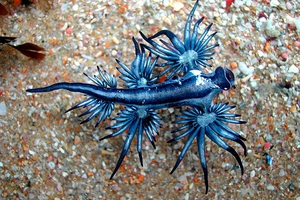Description
Also known as Aeolus, Atlanticus Sea Slug, Blue Angel, Blue Dragon, Blue Dragon Sea Slug, Blue Glaucus, Blue Ocean Slug, Blue Sea Dragon, Blue Sea Lizard, Blue Sea Slug, Blue Tide Animal, Common Man-of-War Nudibranch, Glaucus, Nudibranch, Pelagic Aeolid, Pokemon Sea Slug, Sea Lizard, Sea Swallow, The Blue Fleet.
Found upside down on the surface of the water, they use their gas filled sac to swallowing air bubbles to maintain their buoyancy, drifting with the currents and winds throughout the worlds oceans.
They feed exclusively on venomous siphonophores like the Bluebottle - Portuguese Man-o-War.
Length - 4cm
Depth - Surface
Circumtropical
These beautiful sea slugs can also sting because they recycle the stinging cells from the Portuguese man-o-war to use for their own defence.
Opisthobranchia - Nudibranchs - Sea Slugs meaning "naked gills" are molluscs without a hard shell.
All opisthobranchs are hermaphrodites.
These beautiful slugs are usually brilliantly coloured and this in itself can act as a deterrent against predators. Some sea slugs secrete acid from stinging cells in their tentacles while others secrete acid from cells in their mantle.
Nudibranchs are slow moving, can swim or be propelled along either by muscular contraction or by millions of tiny hairs on the bottom of a fleshy 'foot', they have a voracious appetite and feed with a rasp like tongue.
Nudibranch lay their eggs in a ribbon effect on the sand, in different colours depending on species. Ref: http://www.seaslugforum.net/find/glauatla









1 comment
Posted by WillThank you for sharing this information